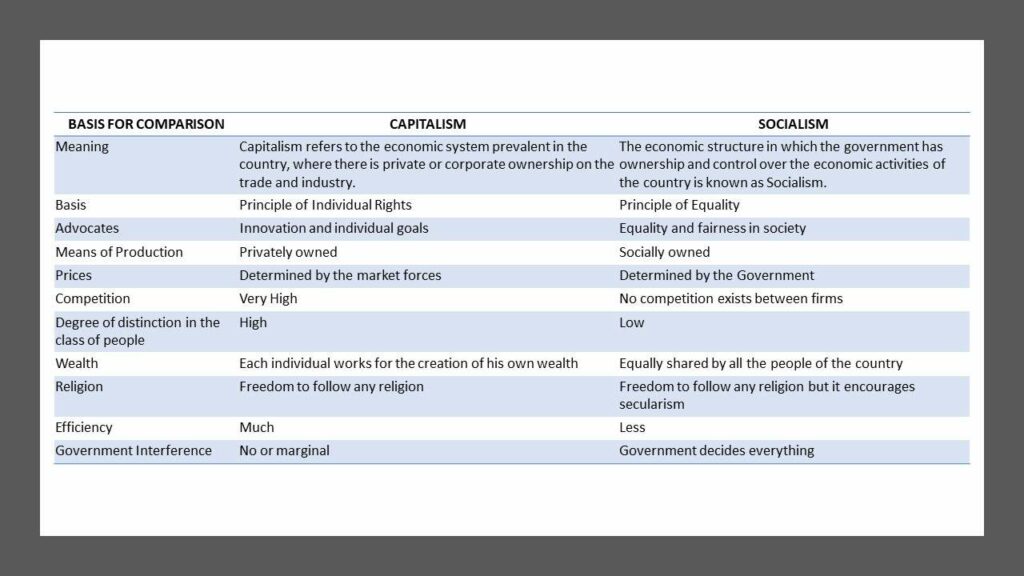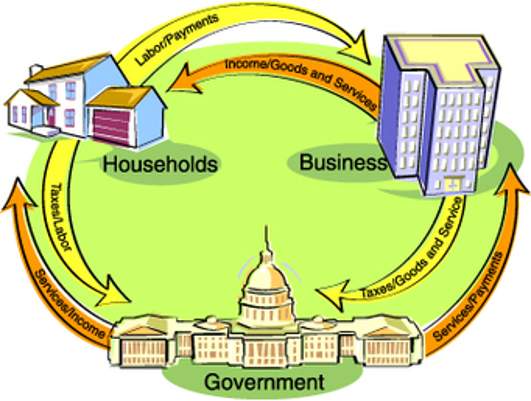Chapter 2 – A National View
Economic Systems
Nations select the economic system used in their country, although many nation’s current systems come from systems dating almost 1,000 years ago. Looking at two of the most common systems, capitalism (sometimes called a free market system) and socialism, provides insight into the importance of understanding the role of business, ownership of business and the motivation of workers in an economic system to appreciate why a business in one country makes decisions and operates markedly different from a business in another country.
The KeyDifference website provides a comparison of capitalism and socialism in Figure 4 for our discussion. As we look at the comparison, we begin to see that there are pros/cons in each system. For instance, socialism’s focus on equality and fairness results in wealth to be equally shared by all the people of the country, which is a good thing. But, in practice, this often dampens the passion for innovation found in capitalism where an individual has greater motivation because they share more fully in the wealth and opportunity created from their innovation. Understanding the possible trade-offs in an economic system has led to many economic systems evolving to more a blending of systems to deliver benefits desired by society. One has to wonder if it might be possible to combine characteristics from both capitalistic and socialistic systems to form an economic system that gives the best from each?
Review the comparison below at your own pace to discover possible pros and cons from your perspective. What trade-offs are you willing to take or not take in an economic system if you could choose?


Gross Domestic Product Measures Economic Activity
Gross Domestic Product (GDP) is the total monetary value of all goods and services produced within a country during one year. The World Bank tracks GDP of countries throughout the world, graphically showing each country’s economic performance and its ability to maintain a healthy marketplace.
GDP can vary from year to year based on what events occurred, how workers performed, or what inefficiencies surfaced that challenge the work done. For example, the U.S. GDP grew by 2.2% in 2013, 2.4% in 2014 and 2015, and 1.6% in 2016. Upon analysis, we learn that the U.S. had economic incentives that provided impetus for 2014 and 2015 results.
As you learned in Chapter 1, the 4th Industrial Revolution is forecast to have a disruptive impact on economic activity in the coming years, particularly for those who are not getting ready and preparing for the disruption. How might a lack of readiness impact GDP and the economic health of a country?
Let’s take a closer look at the national level of U.S. economics in Fig. 3 below, to see how a capitalistic economy or free market economy works by understanding the roles of the country’s three sectors of the economy — household, business and government — to deliver a standard of living for its citizens and a healthy economy.

Households are consumers that spend their resources, such as money and time, to buy goods and services from the marketplace to satisfy their wants and needs. Households are also the productive resources of a country because they serve as workers in many businesses. This combined role gives the U.S. consumer tremendous responsibility in the economics of the country because they can choose to buy fairly or not buy products and services, as well as diligently choose to work or not work to provide products and services for the marketplace. Think of households as the resources for the U.S. economy.
Businesses include the organizations that undertake the work of combining tangible and intangible resources to produce goods and services that consumers want and need. Businesses provide people with work to do, as well. Also, enterprises buy capital goods, such as buildings and equipment, as they invest resources to keep the business operating and producing efficiently and effectively. Businesses are the production sector of the U.S. economy. In the U.S., businesses are in the private sector because they are not government-owned. Companies such as Google, Apple, Boeing that focus on making a profit or even United Way, a large not-for-profit, are all in the private sector.
The government is the regulating sector of the U.S. economy. It includes ruling bodies of federal, state and local governments that pass laws, collect taxes and force the household and business sectors to do what they may not do voluntarily to provide a robust and healthy economy for its citizens. Most regulatory oversight rests in federal departments, commissions or agencies such as the Agricultural Department (USDA), Federal Communications Commission (FCC) or the Federal Emergency Management Agency (FEMA). By regulating the economy, the government sector ensures the availability of the marketplace for all economic players – households, businesses and government. Organizations and institutions such as public schools, Federal Communication Commission (FCC) and even some universities such as Purdue University are owned by federal, state or local level governments throughout the U.S. and make up the public sector.
Rules of the Game
As you’ll recall from Figure 4, Comparison Between Capitalism and Socialism, the U.S. economy is based on a high level of competition among businesses. Businesses generally compete with other businesses who are in the same sector and industry as them. A business industry is a group of companies that are similar in the primary business activities they are engaged. Industries are typically grouped in larger categories called sectors. The North American Industrial Classification System (NAICS), the industry system used in the U.S., has dozens of classifications of businesses that help businesses understand who their competition is by assigning businesses a NAICS industry code. For instance, an auto manufacturer will compete against other auto manufactures. In Figure 5, we see that auto manufacturers are in the manufacturing sector, Sector 31-33, and have an industry code of 33611. An auto manufacturer would look at businesses that have a NAICS industry code of 33611 to learn what they are doing and how it might impact their business. If a company has multiple lines of business activities, they are classified by the business activity that brings in the most revenue.

Competition among businesses motivates them to continually deliver products and services to consumers that meet their evolving needs and wants. It is a constant churn of innovation and enhancement. While there is no such thing as perfect competition, William F. Arens, author of Contemporary Advertising, describes the four fundamental assumptions of free-market economics that drive the strategies of business in the U.S.
Review the principles below at your own pace to consider how each principle might guide you as a communication professional when developing content for a business. Does self-interest give you insight into the receiver of content? Do many buyers and sellers give you an appreciation for the amount of information that inundates the receiver of your message?

Based on what we have covered in chapters 1 and 2, we now have a general idea of how businesses in the U.S. see their role. How does this role affect the running of a business and business behavior in the U.S.?
- Businesses are in the private sector with minimal government interference, so they feel they can use resources in a manner they think fit or are compelled to do. Consider: Who sets the standard for the usage, sourcing and replenishment of resources used in a business?
- The Principles of Free-Market Economics gives buyers and sellers the freedom to engage in the economic activity of their choice by providing multiple options as well as access to the information to make that choice. Consider: Who ensures information is not only accessible but valid and reliable to inform seller and buyer choice?
- The profit motive encourages both people and businesses to work hard and earn wealth, thus driving innovation, creativity and resilience to a change in economic conditions. Consider: Who considers ethical implications when pursuing innovation and creativity?
Understanding the global, national and industry economic influences on business helps us foresee and control influences that can be and those that cannot, as the business environment is in constant motion and changing.
After the checkpoint in Chapter 2, we get down to the business level in Chapter 3 when we look at different types of companies and how type affects the business structure, relationships and economic decisions.


